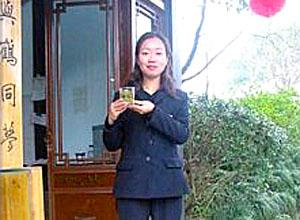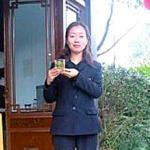Tea for You in Long Jing
If one would merely slake his thirst, then he can drink rice and water. Should melancholy, sadness or anger strike, he can turn to wine to drink. But if one would dispel an evening's unproductive lassitude, the meaning of "drink" is tea.
Lu Yu, "Tea Classics"
A few hours and a world away from the relentless hustle of Shanghai sits a small town nestled in gently rolling green hills. Named for a legendary well in it's center, from which the purest waters are said to spring, the village is called Long Jing. To aficionada of fine green tea, the name Long Jing is spoken with respect, as revered a place to such devotees as California's Napa Valley or France's Bordeaux region is to connoisseurs of fine wine. Like Bordeaux, the rolling hills of Long Jing are as nurturing to the eyes and spirits of visitors as its soil is to its highly specialized and much prized crop. And like Napa, the people of Long Jing are dedicated to the nurture and perfection of a substance capable of infinite subtleties.
"Of all the places where fine teas are grown, Long Jing is perfectly situated to produce the finest green tea in China, and probably in the world" Says Shen Xiu Jing, the elder of two sisters who run one of the many shops along the main road that both sell tea leaves and offer visitors to sample a variety of local teas. "Other regions are good for other teas. But Long Jing has just the right climate, altitude and soil type to produce green tea, which is among the most subtle and delicate of all teas."
Ms. Shen then produces three varieties of tea for sampling. The first two are called Gu Yu Qian and Ming Ho, and at under 15 RMB per 50 grams, are not expensive by local standards. She puts the leaves from both into clear glasses and slowly pours in the water. "There are many methods for making tea, but the proper way to brew Long Jing tea is to use a glass. This way, one can judge its quality with the eyes, as well as with the nose and tongue."
The third tea is called Ming Qin Long Jing, and at 45 RMB per 50 grams, is far more expensive. "This tea is harvested once a year, as opposed to the other two, which are harvested twice." The Ming Qin has a lighter color, a more delicate scent, and a slightly sweeter undertone. "The best time to buy this tea is in the last week of April." She says "That's when the prices will be the lowest."
In addition to being an ideal place to buy green tea, the village of Long Jing also houses China's foremost museum of tea, where visitors can learn the history and mythology surrounding China's most revered beverage and sample a variety of different teas from around the country in idyllic surroundings.
* * * * *
Fact File
Hangzhuo can be reached by train from Shanghai in under three hours, and tickets cost around RMB 30.
The town of Long Jing is a few kilometers outside of Hangzhuo, and can be reached by taking city bus #27 or tourist bus #3.
Admission to the Tea Museum is RMB10.
* * * * *
This article originally printed in City Weekend Magazine.
* * * * *
 ThingsAsian
ThingsAsian

















